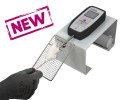Authors
J. Luszczki, M. Trojnar, N. Ratnaraj, P. Patsalos, S. Czuczwar.
Lab
Medical University of Lublin, Department of Pathophysiology, Lublin, Poland.
Journal
Epilepsy Research
Abstract
The aim of this study was to characterize the anticonvulsant effects of stiripentol (STP) in combination with clobazam [CLB], and valproate [VPA]) in the mouse maximal electroshock (MES)-induced seizure model using the type I isobolographic analysis for parallel and non-parallel dose-response relationship curves (DRRCs). Potential adverse-effect profiles of interactions of STP with CLB and VPA at the fixed-ratio of 1:1 in the MES test with respect to motor performance, long-term memory and skeletal muscular strength were measured along with total brain antiepileptic drug concentrations. In the mouse MES model, STP administered singly had its DRRC non-parallel to that for CLB and, simultaneously, parallel to that for VPA. With type I isobolography for parallel DRRCs, the combinations of STP with VPA at three fixed-ratios of 1:3, 1:1 and 3:1 exerted sub-additive (antagonistic) interaction. Isobolography for non-parallel DRRCs revealed that the combination of STP with CLB at the fixed-ratio of 1:1 produced additive interaction. For all combinations, neither motor coordination, long-term memory nor muscular strength was affected. Total brain antiepileptic drug concentrations revealed bi-direction changes with the most profound being an 18.6-fold increase in CLB by STP and a 2.3-fold increase in STP by VPA. In conclusion, the additive interaction between STP and CLB was associated with a concurrent pharmacokinetic interaction and these data may explain the clinical efficacy seen with this combination. In contrast, the antagonism between STP and VPA was surprising since synergism is observed clinically.
BIOSEB Instruments Used:
Grip strength test (BIO-GS3)

 Pain - Thermal Allodynia / Hyperalgesia
Pain - Thermal Allodynia / Hyperalgesia Pain - Spontaneous Pain - Postural Deficit
Pain - Spontaneous Pain - Postural Deficit Pain - Mechanical Allodynia / Hyperalgesia
Pain - Mechanical Allodynia / Hyperalgesia Learning/Memory - Attention - Addiction
Learning/Memory - Attention - Addiction Physiology & Respiratory Research
Physiology & Respiratory Research
 Pain
Pain Central Nervous System (CNS)
Central Nervous System (CNS) Neurodegeneration
Neurodegeneration Sensory system
Sensory system Motor control
Motor control Mood Disorders
Mood Disorders Other disorders
Other disorders Muscular system
Muscular system Joints
Joints Metabolism
Metabolism Cross-disciplinary subjects
Cross-disciplinary subjects Preclinical studies and opioids: role in crisis management in the United States
Preclinical studies and opioids: role in crisis management in the United States 